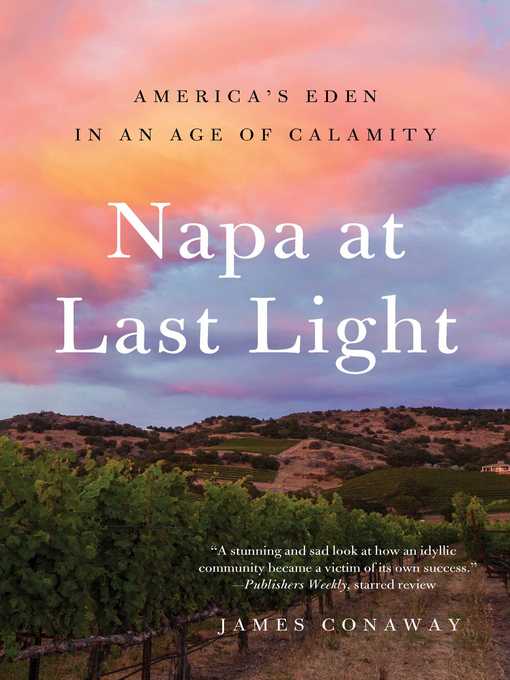
Napa at Last Light
America's Eden in an Age of Calamity
کتاب های مرتبط
- اطلاعات
- نقد و بررسی
- دیدگاه کاربران
نقد و بررسی

Starred review from October 30, 2017
In this fascinating and well-researched book, Conaway delivers an unpleasant portrait of California’s Napa Valley in the 21st century. Conaway knows his subject well, having written two previous narratives chronicling the valley’s metamorphosis over the decades (including Napa: The Story of an American Eden). Several sections of the book explore “specific struggles similar to those all over the country but heightened by Napa’s fame and outsized concentrations of wealth and notoriety.” The 1960s through the ’80s were a golden age for Napa. Newcomers filled with idealism flocked to the valley wanting to learn the art of wine making, all the while respecting sound conservation principles. But once big money arrived, personal bonds among the community members began disintegrating and land-zoning and water-use issues divided Napa residents. Once a mainly mixed-agriculture region that also happened to produce wine, Napa morphed into an oenophile Disneyland, according to Conaway, where new-millionaire winemakers have little regard for the natural environment or quality of life for longtime valley residents. This is a stunning and sad look at how an idyllic community (which has recently been ravaged by fire) became a victim of its own success.

November 15, 2017
In the third volume of his trilogy about Napa, California, Conaway (Nose, 2013, etc.) continues his investigation of the consequences of the wine industry on the region's culture and environment.Both, argues the author persuasively, suffer at the hands of greedy winemakers, huge corporations, and the desire of merchants to attract more and more tourists. As in his past books, this one is filled with detailed--and sometimes overly detailed--sketches of a large cast of characters. Conaway profiles more than 60 individuals who, in one way or another, affect Napa's life and fortunes. These include winery founders, vintners ("mostly an ornamental title nowadays"), growers (a dwindling number), inheritors, and the handful of determined citizens working hard to defend the ecology and integrity of the land they love. The author notes that nearly half of the population of Napa Valley lives at or below the poverty line; housing is "prohibitively expensive, the roads crowded, cancer rates high, and the glaring disparity between incomes growing." But his focus here is not on economic or health problems but rather on environmental damage when agricultural production is impeded by marketing, when wineries are converted "into retail shops, conference pods, and de facto restaurants." Wineries, he writes, have become "self-interested fiefdoms" overseen by astoundingly wealthy vineyard owners, too often international corporations. Some vintners have no knowledge of grape-growing and little interest in the actual work of farming. Many, Conaway writes, "are caught up in what amounts to a parody of viticulture, elaborate dramas of money and celebrity far removed from the dust from which hope springs eternal." One man, seeking "self-realization" as a vintner, confessed that he wanted to make "a difference to people and their experiences," which, Conaway says scornfully, "is what real estate development and tourism are all about, not agriculture." The author ends on a "guardedly optimistic" note, citing citizens' successes in holding back development and exploitation.A strong plea for responsible stewardship of the land.
COPYRIGHT(2017) Kirkus Reviews, ALL RIGHTS RESERVED.

February 15, 2018
Fine wines, a wondrous setting, infighting among the locals over development and conservation--Napa may be America's Eden, but there are serpents in the garden. Author Conaway (The Far Side of Eden) returns to writing about the hidden side of the California region famous for its vintages, pulling back the curtain on a series of interconnected commercial maneuvers and accompanying disputes. As the book progresses, the tangled interrelations among the various players becomes all the more fascinating. No one person is truly the hero of this work. Indeed, Conaway skillfully shows that the many people involved are each deeply complex. For those who see Napa as an idyllic destination, the book may prove unsettling. Still, it is an excellent look into competing ventures at play in an area rich in history and rooted in one particular industry. VERDICT Vivid storytelling by an author who knows the Napa Valley geography and people well. Recommended for a range of collections, not just where books on wine are popular.--Peter Hepburn, Coll. of the Canyons Lib., Santa Clarita, CA
Copyright 2018 Library Journal, LLC Used with permission.

























دیدگاه کاربران